Learn how to make samosa from scratch with this step-by-step guide. Master the dough, filling, and frying process to create crispy, flavorful samosas at home.
If you’re a fan of crispy, golden samosas, you know how irresistible they can be. Whether you enjoy them as a snack, appetizer, or part of a festive meal, samosas are the perfect blend of crunchy dough and flavorful filling. But let’s be honest—store-bought versions or frozen ones don’t quite compare to the fresh, homemade ones that are made with care and love.
How to make samosa from scratch? This seems intimidating, especially if you’ve never tried it before. From getting the dough just right to mastering the perfect folding technique, it can feel like a lot to handle. And then there’s the frying—getting them crispy without being greasy is a whole skill of its own.
But don’t worry—the good news is making samosas from scratch is easier than you think. In this guide, I’ll walk you through each step of the process, from preparing the dough and filling to frying them to crispy perfection. By the end of this post, you’ll have the confidence to create your own delicious, homemade samosas that are far better than anything you’d find in a store.
Table of Contents
Understanding the Basics of Samosas
Before diving into the recipe, let’s take a moment to understand what makes a samosa, well, a samosa.
What is a Samosa?
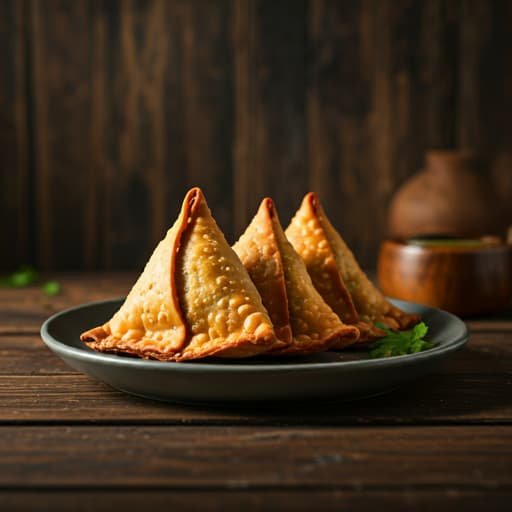
A samosa is a deep-fried pastry that’s typically filled with a savory mixture. While it’s widely known as a snack in India and South Asia, it has roots in the Middle East and Central Asia. The classic samosa filling is usually made with spiced potatoes, peas, and onions, but there are endless variations—including meat, cheese, or even sweet fillings.
Why Make Samosas from Scratch?
Making samosas from scratch is very much a pleasure, for you can tailor all your desired fillings, you have control over ingredients, and one tastes fresh food prepared in the comfort of your home. Whether a novice or an experienced cook, there is some magic behind making a batch of crispy wonders in your kitchen. Not to forget, homemade samosas will always have that flavor and texture that those buy ones just cannot match.
Ingredients You’ll Need
For the Dough:
- 2 cups all-purpose flour
- 1/4 teaspoon salt
- 4 tablespoons oil or ghee (clarified butter)
- 1/2 teaspoon carom seeds (ajwain) – optional
- Water (about 1/2 cup, or as needed)
For the Filling:
- 3 medium potatoes, boiled and mashed
- 1/2 cup peas (fresh or frozen)
- 1 small onion, finely chopped
- 1 tablespoon ginger, grated
- 1-2 green chilies, finely chopped (optional for heat)
- 1 teaspoon cumin seeds
- 1 teaspoon coriander powder
- 1 teaspoon turmeric powder
- 1 teaspoon garam masala
- Salt, to taste
- 1 tablespoon lemon juice
- 2 tablespoons fresh coriander leaves, chopped
- 1 tablespoon oil for cooking the filling
For Frying:
- Vegetable oil or sunflower oil (quantity sufficient for deep frying)
How to Make Samosa Dough
The dough is the base of your samosas, and getting it right is key to achieving that crispy, flaky texture.
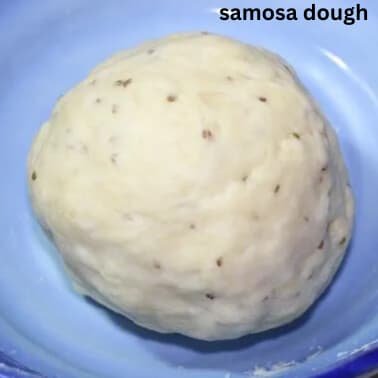
- Mixing the Ingredients: In a large mixing bowl, combine the flour, salt, and carom seeds, if you are using any. Add the oil or ghee and rub it into the flour using your fingers until the mixture resembles coarse breadcrumbs.
- Adding Water and Kneading: Gradually add water, a little at a time, and mix it into the flour. Knead the dough until it is firm and smooth. The dough should not be too soft or sticky; it should have a slight elasticity. Once done, cover the dough with a slightly wet cloth and let it rest for 20-30 minutes. This resting period helps to relax the gluten, making the dough easier to roll out.
For more such delicious recipes, click here.
How To Make Samosa Filling
The filling is where you can get creative. Traditional samosas are often made with spiced potatoes and peas, but you can easily adapt the recipe to suit your preferences.
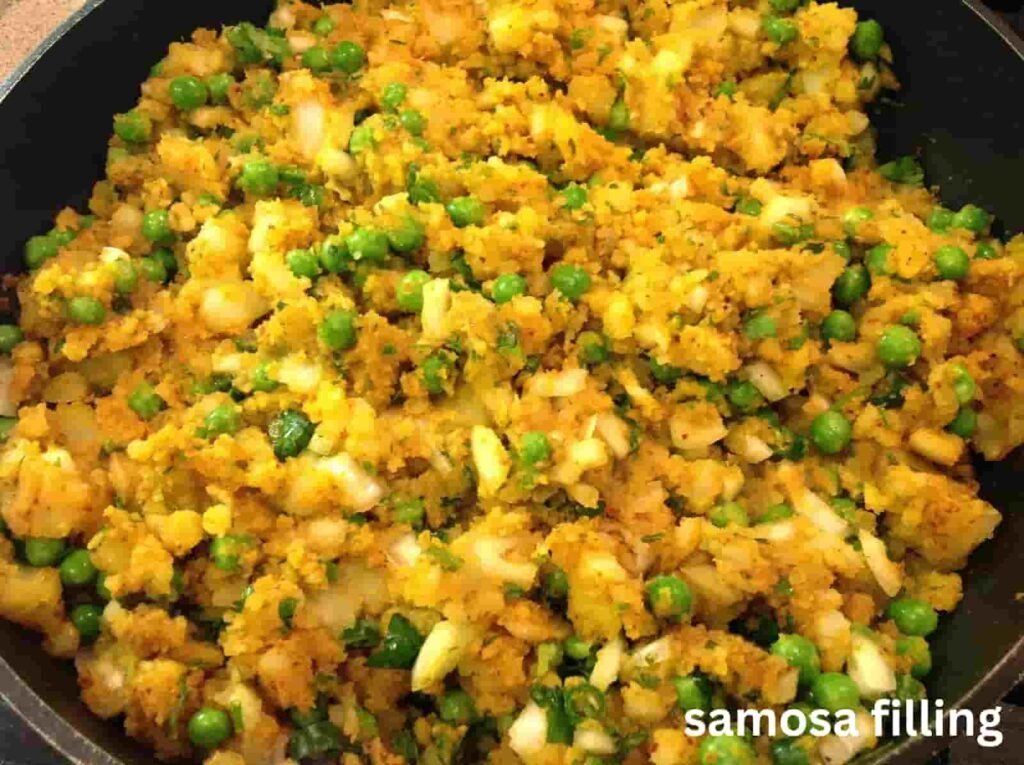
- Heat 1 tablespoon of oil in a pan over medium heat. Add cumin seeds and allow them to splutter. Then, add the chopped onions and fry until golden brown. Add the grated ginger, green chilies, and all the dry spices (coriander, turmeric, garam masala). Stir for a minute until fragrant.
- Add the boiled potatoes and peas to the pan and mash them lightly, mixing well with the spices. Cook for 3-4 minutes, then remove from heat. Stir in lemon juice and fresh coriander leaves. Allow the mixture to cool before using it for filling your samosas.
- Taste the filling and adjust the seasoning—add salt or more spices as needed. If you want a spicier filling, you can add a pinch of chili powder or chopped green chilies.
How To Make Samosa: Shaping and Assembling
Now comes the fun part—shaping your samosas. While it may seem tricky at first, once you get the hang of it, you’ll be able to fold them in no time.

- Rolling the Dough: Divide the dough into small, equal-sized portions (about 10-12 pieces). Roll each portion into a ball and flatten it into a circle or oval, about 4-6 inches in diameter, Using a rolling pin to get an even thickness.
- Creating a Cone Shape: Cut each circle in half. Take one half and form a cone by folding it into a triangle shape, sealing the edge with a just little water.
- Stuffing and Sealing: Fill the cone with the prepared filling, but don’t overstuff it—leave a little space at the top for sealing. Pinch the open edges together to seal the samosa, ensuring there are no gaps. This will help prevent the filling from spilling out during frying.
Frying the Samosas
Frying is where your samosas really come to life, turning golden and crispy.
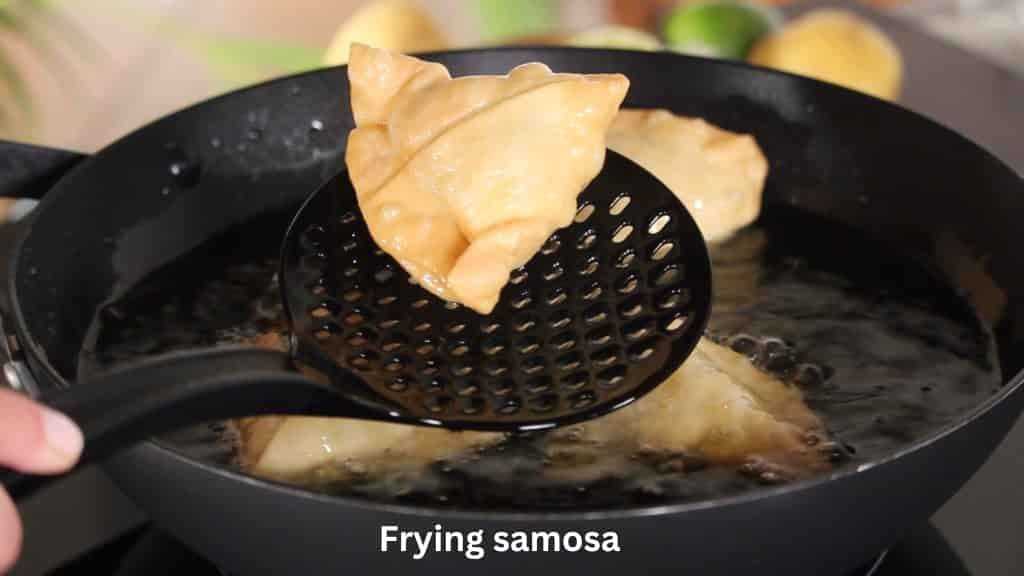
- Heating the Oil: Heat oil in a deep frying pan over medium heat. The oil should be hot, but not smoking. You can test the oil by dropping a small piece of dough into it—if it rises to the surface immediately, the oil is ready for frying.
- Frying the Samosas: Carefully drop the prepared samosas into the hot oil, a few at a time. Don’t overcrowd the pan. Fry the samosas for 6-8 minutes, turning them occasionally, until they are golden brown and crisp on all sides.
- Draining Excess Oil: Once fried, remove the samosas and place them on a paper towel-lined plate to drain excess oil.
Tips for Perfect Samosas
- Consistency of Dough: The dough should be firm, not too soft. If it’s too soft, the samosas may open up during frying and also the samosas may not have a perfect shape.
- Filling Considerations: Make sure the filling isn’t too wet—moisture can cause the dough to become soggy and the samosas will not be crispy for a longer time. If you’re using potatoes, make sure they’re well-drained and mashed.
- Oil Temperature: Keep the oil temperature consistent. If the temperature of the oil is too high, then the samosas will brown too quickly without cooking through; and if it is too low then the samosas will absorb too much oil.
Variations and Customizations
Feel free to get creative with your samosas. Here are a few ideas for different fillings:
- Vegetarian Samosas: Try filling them with a mix of carrots, spinach, and cauliflower.
- Meat Samosas: Ground chicken, lamb, or beef mixed with spices is a hearty alternative.
- Vegan Samosas: Use lentils or chickpeas as a filling for a plant-based option.
- Mini Samosas: Perfect for parties—make smaller versions for easy snacking.
Serving and Enjoying Your Homemade Samosas
Samosas are best enjoyed hot and fresh. Serve them with a variety of dipping sauces, like tangy tamarind chutney, cool mint-coriander chutney.
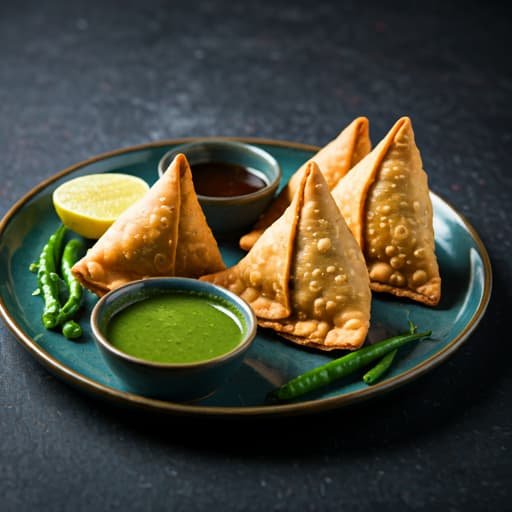
Pairing Ideas: Enjoy your samosas with a cup of masala chai for the ultimate snack or appetizer. You can also serve them as part of a larger meal with rice or salad.
Storage Tips: Leftover samosas can be refrigerated for up to 2-3 days. Reheat them in an oven or air fryer to maintain their crispiness. You can also freeze uncooked samosas for later use—just fry them straight from the freezer!
For a detailed recipe video, click here.
Making samosas from scratch is a fun and rewarding experience. With a bit of practice, you’ll master the dough, filling, and frying process to create crispy, flavorful samosas that will impress family and friends. So go ahead—grab your ingredients, follow these simple steps, and get ready to enjoy homemade samosas that are a cut above anything you can buy. Happy cooking!






